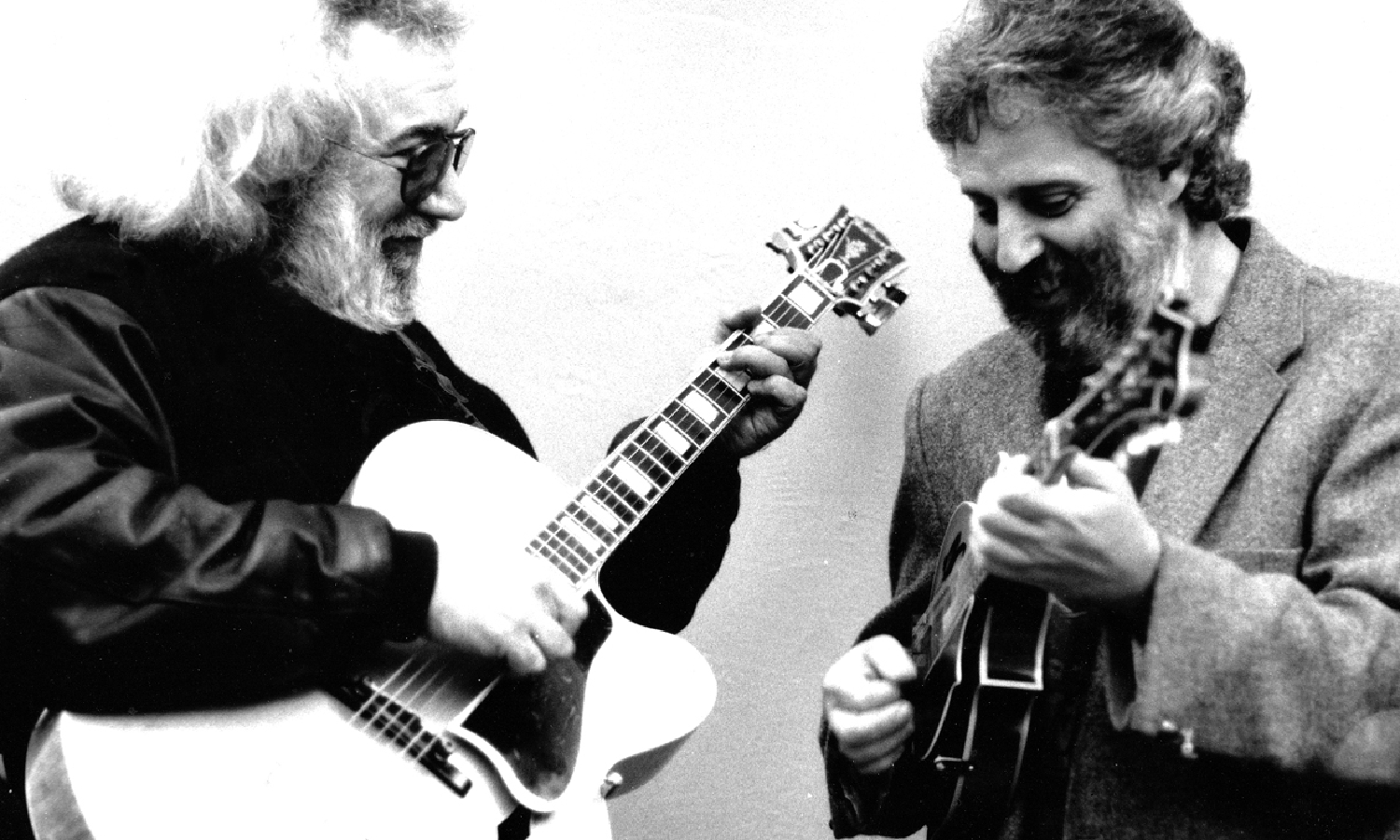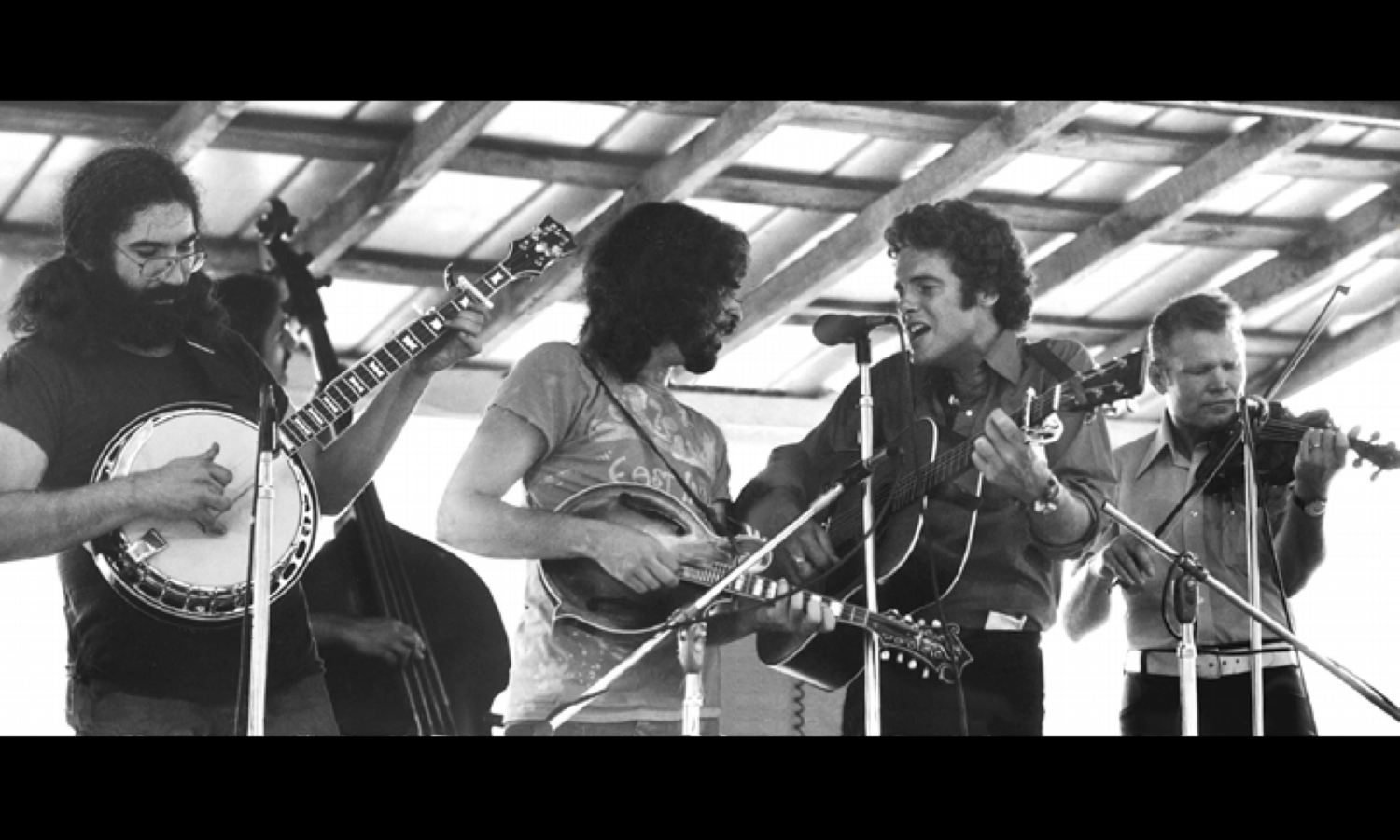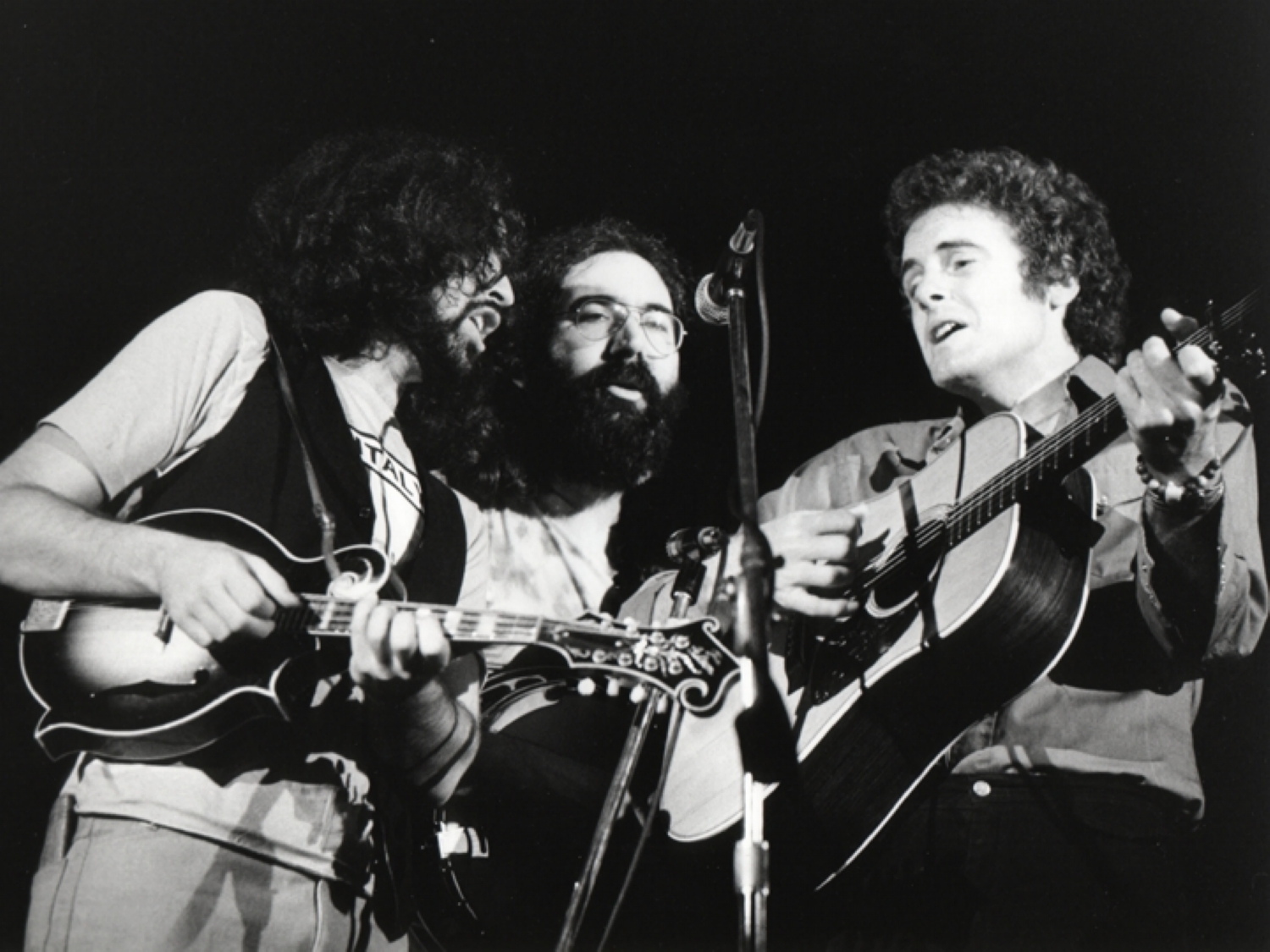The Thrill Lives On: David Grisman Reflects on Jerry Garcia

Between 1972 and 1982, Jerry Garcia put out five studio albums. It would be nearly a decade before he entered a studio to record material with his name on the cover of the final product. (In the interim, there were plenty of live Garcia releases to satiate fans.)
When that new studio album came in 1991, another name bore equal footing next to Garcia’s: David Grisman. For those relatively new to the scene, the mandolinist’s name was unfamiliar. For older Deadheads in the know, it was a pleasant blast from the past: Grisman and Garcia had played together in the late ‘60s and eventually formed a short-lived band in the early ‘70s called Old & In The Way, which included bassist John Kahn, guitarist/singer Peter Rowan and legendary bluegrass fiddler Vassar Clements.
While Garcia had deep roots in acoustic music, certain demands didn’t always allow him to pursue it as much as he would have liked to throughout the ‘70s and ‘80s; though, there were sporadic indulgences both with the Grateful Dead and with his various solo projects that revealed his continued fondness for the medium.
In his reconnection with Grisman, Garcia found a consistent and reliable outlet for string music that he hadn’t had in decades. This was, in part, due to the fact that the two men lived close to each other; it was also due to the fact that Grisman, at the time, had just launched his own Acoustic Disc record label and built a studio in the basement of his home, which made for easy access to a high quality recording environment.
During the next five years, the two would cut more than forty sessions in the studio to yield six more albums. (Their story is poignantly captured in the documentary Grateful Dawg, directed by Grisman’s daughter Gillian, who shot much of the footage with Justin Kreutzmann, son of Dead drummer Bill Kreutzmann.)
On the eve of what would have been Jerry Garcia’s seventieth birthday, Acoustic Disc is releasing a new high-definition version of the seminal Garcia/Grisman debut along with a complete album of alternative takes following the same sequence. These titles, back catalog and forthcoming releases featuring Garcia are available at AcousticOasis.com.
In honor of his late friend’s birthday, Grisman reflects on his long-standing musical adventures with Garcia and their friendship.
There are conflicting reports about when and where you and Jerry first met. Can you confirm that it was in West Grove, Pa., in the parking lot of a Bill Monroe show in 1964?
Yes. 1964. Sunset Park, West Grove, Pa. – a great place where you could hear live bluegrass music on Sunday afternoons during the summer months. We would jam in the parking lot in between sets with local musicians and other urban pickers. I saw all the bands there back then and that’s where Jerry and I met.
In 1965, you visit California to hang with Jerry and other musically likeminded folks. At the time, The Warlocks – soon to be the Grateful Dead – were getting their footing. They made enough of an impression on you that when you returned to New York, you told Izzy Young about them and he relayed it in his Sing Out column “Frets and Frails,” giving the Dead their first piece of national press. Given that most readers will never read what Izzy wrote, what was your impression of them overall and of seeing Jerry in that electric context?
I was impressed by Jerry and The Warlocks as they were incorporating bluegrass, old-time, and other “rootsy” influences and sensibilities into a rock and roll context. They were also having a lot of fun doing it. It was definitely a departure from most of what was going on at the time and a lot less slick, down-to-earth music with electric instruments. They were playing high school swimming pool parties!

Before disbanding, Old and in the Way did approximately 25 dates in 1973, with Jerry doing Grateful Dead dates in between gigs and – to my understanding – Old in the Way sometimes hanging at the Dead shows. Can you recall another musician that seamlessly moved from a powerfully electric setting like the Dead to the string based music of O&ITW?
I don’t recall O&ITW ever hanging at Grateful Dead shows. There really was no interaction at all between the two groups. I think, by that time, the other members of the Grateful Dead were quite taken with their recently found celebrity and didn’t seem to be interested in our bluegrass band. Bill Kreutzmann was always friendly to me, but, in truth, I think the others regarded us as competition. Jerry was always the true renaissance music man, who took the time to absorb these wonderful American traditions and do them justice.
Were there others who moved easily from electric to acoustic? Absolutely. David Lindley, who I just saw the other day, was one and, of course, Ry Cooder and Taj Mahal. Bonnie Raitt and John Sebastian were both adept at acoustic and electric blues, and even Peter Rowan and I formed our own “folk-rock” ensemble, Earth Opera, where I became the first (and probably only) plugged-in fuzz-tone mandocello player. We opened shows for The Doors, The Jeff Beck Group with Rod Stewart and Ron Wood, Janis Joplin, The McCoys and others.
To that end – and this goes for your entire musical relationship with Jerry – was his electric playing or fluency tangible in how he approached acoustic music?
Absolutely. Jerry’s style crossed both worlds perfectly. And the amazing thing was how his wonderfully expressive tone transcended both idioms. You always knew it was Jerry because of his sound – acoustic or electric.
The members of Old in the Way all had nicknames. It was Jerry who gave you the name “Dawg.” His name, in turn, was “Spud Boy.” Can you relay the origins of the names and who came up with Spud Boy for Jerry?
Sorry, but I can’t. It was all very casual and off-the-wall. I didn’t even remember that Jerry gave me the Dawg moniker until he reminded me one day when we were listening to some tapes in my studio.
Vassar Clements – who was at the peak of his playing at the time – elevated Old and in the Way when he joined the group in 1973. Jerry, in particular, was thrilled with his inclusion. Can you talk about the late, great fiddler’s impact on the group and what kind of relationship he and Jerry had?
Vassar was a major hero for all of us, and a legend. He played on many of Bill Monroe’s classic recordings, as well as some of the great records by Jim & Jesse. We all became fast friends and had a lot of fun together. I remember once telling him how amazing it was for us “kids” to be playing with a musician of his stature. His reply was something I’ve never forgotten: “I’m just the same as you. I’ve just been here longer.” He was a master of improvisation and I know he and Jerry were on the same wavelength.
Owsley Stanley III recorded all of the Old and in the Way shows from 1973. To date, I believe only three have been released: Old and in the Way, That High Lonesome Sound and Breakdown. Who has those reels and might we hear more archival releases from that ‘73 run?
I have most, if not all, of the live master tapes, including the Boarding House shows as well as quite a few others. I hope to release the complete Boarding House recordings, in their original sequence, and have had those ready to go for quite some time. Now, with our new series of High Definition downloads at Acoustic Oasis, those tapes will sound better than ever.
Old and in the Way cut a studio album but you and Jerry didn’t think it was good enough to release, correct? Will it remain unreleased or parts or all of it be released at some point?
I haven’t heard those recordings in years. I do know that they were missing for several decades and were re-discovered several years ago. They didn’t have the energy of the live performances, although there were some gems there that I recall. To be honest, my main focus is today. As they say, “Past is prologue.”

When you and Jerry reconnected in 1990, it had been 15 years since you two had made any music together. From your perspective, what inspired or catalyzed him to rekindle that relationship?
We met at a recording session for Pete Sears, and had a long talk. Sometime after that, I received an award from the Rex Foundation in the mail – the Grateful Dead’s charitable arm. [It was] the Ralph J. Gleason award [which is] given to a musician every year who they consider to have made a contribution to music. I heard that it was Jerry who recommended me and I called him up to thank him.
When we spoke, he expressed an interest in getting together to play. He came over to my house and walked in and said, “What we should do is make a record. It will give us an excuse to get together.” I said that I just built a studio in my basement and started my own record label, Acoustic Disc.
He said, “Well, we’ll do it for your label.” I said, “When do you want to start?” and he said, “Now.” So we went downstairs and I set up some microphones and called a young engineer who was looking to work in my studio, Dave Dennison. Before Dave arrived, I had recorded a free improvisation – the first music we played in about 15 years. That was the start of our collaboration that lasted until two weeks before Jerry passed away, when we recorded his last session to my knowledge.
Throughout the next five years, you two recorded 40-plus sessions at your home studio not to mention live dates. While there’s been a healthy amount released – seven albums and a smattering of tunes on various collections – and a forthcoming album of alternative takes of Garcia/Grisman, what else is waiting in the wings?
Well, I plan to issue expanded versions of all the projects with extra takes that have never been released – all in hi-definition – starting with the first Garcia/Grisman album, with its companion alternate collection with great previously un-issued takes of every tune. There are also the live shows that we played together, but I don’t have copies of most of that. It was great for us to get together in those last years for Jerry, but as I mentioned, my focus is on playing music now with my Quintet, Sextet, Bluegrass Experience band and FolkJazz Trio.
During the years, you’ve recorded your original compositions with some of the best guitar players in the business. In what ways did Jerry bring something different to your music and compositions that you didn’t hear or feel elsewhere? Any particular examples?
I’ve always tried to keep each musical collaboration in its own separate space, with its own repertoire. So, for the most part, the original music that Jerry and I played was written on the spot with the two of us in mind. We wrote “Grateful Dawg” together and I wrote “Dawg’s Waltz,” “Dawgnation” and “Arabia” with Jerry sitting right there. So they were definitely inspired by his presence and conceived with him in mind. Playing with great musicians has always been an inspiration for me and that’s the way it worked with Garcia. He was one-of-a kind and a true friend. I think of him every day.
This August would’ve marked Jerry’s 70th birthday. What do you envision that he might be up to if he were still with us today?
Well, Jerry once remarked to me that we’d play together for the rest of our lives and though he’s been gone for 15 years, I feel he’s still here. Hopefully I’m keeping a small part of him alive in what I play, and we can only surmise what kind of music he’d be making now. I’m truly the “Grateful Dawg.” Happy Birthday, Spud.



















